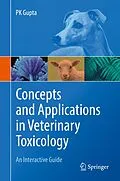This book: "Concepts and Applications in Veterinary Toxicology: An Interactive Guide": covers a broad spectrum of topics related to students specializing in veterinary toxicology and for veterinary medical practitioners. Since the major emphasis of the book is to teach veterinary students, therefore more attention has been given to common toxicants to which several species are exposed including pet animals. The subject of veterinary toxicology is complicated greatly by the wide variations in responses of domestic, companion, aquatic, wild, and zoo species to toxicants. Therefore, emphasis has also been given to species variation and diagnostic toxicology including clinical management that is more relevant to veterinary profession.
Key Features
· Highlights specialized topics essential for veterinary specialists.
· Covers a variety of common toxicants to which several species including pet animals are exposed.
· Includes sample questions and answers that are extremely valuable for students, clinical pharmacists, teachers, and academicians in preparing for their board and other examinations.
Autorentext
Inhalt
Chapter 1: GENERAL AND PRINCIPLES OF TOXICOLOGY
1.0 Introduction 2.0 Key Points 4.0 Roots in Veterinary Medicine and Toxicology 5.0 Current Status 6.0 Toxicology and the Risk of Paradigm7.0 Definitions and Classification of Toxic Agents
8.0 Factors Affecting the Activity of Toxicants
8.1 Factors related to Exposure
8.2 Biological Factors
8.3 chemical factors
9.0 Natural Law Concerning Toxicity
9.1 Dose-Response Relationship
9.2 Statistical Concept of Toxicity 9.3 Variables of Dose-Response Curves 9.4 Interaction with Receptors10.0 Brain Storming Exercises
10. 1 Short Questions and Answers
10.2 Multiple Choice Questions
10.3 Fill in the Blanks
10.4 True or False Statements10.5 Match the Statements
11.0 Answers to Exercises
11.1 Multiple Choice Questions
11.2 Fill in the Blanks11.3 True or False Statements
11.4 Match the Statements
12. Further Reading
Chapter 2: MECHANISM OF TOXICITY
1.0 Introduction 2.0 Key Points 3.0 Definitions 4.0 Mode of Action 5.0 Mechanism of Toxicity6.0 Brain Storming Exercises
6.1 Short Questions and Answers
6.2 Multiple Choice Questions
6.3 Fill in the Blanks
6.4 True or False Statements
6.5 Match the Statements
7.0 Answers to Exercises
7.1 Multiple Choice Questions7.2 Fill in the Blanks
7.3 True or False Statements
7.4 Match the Statements
8.0. Further ReadingChapter 3: DISPOSITION AND TOXICOKINETICS
1.0 Introduction 2.0 Key Points 3.0 Absorption, 4.0 Distribution, 5.0 Biotransformation / metabolism 5.1 Phase I Reactions 5.2 Phase I Reactions 5.3 Elimination 6.0 Induction and Inhibition of Metabolizing Enzymes 7.0 Bioactivation and Tissue Toxicity 8..0 Essentials of Toxicokinetic/Pharmacokinetic Principles 9.0 Plasma Drug Concentration versus Time 10.0 Orders of Rate Processes 11.0 Toxicokinetic Models 12.0 Determination of Dose/Dosage Regimen 13.0 Brain Storming Exercises13. 1 Short Questions and Answers
13.2 Multiple Choice Questions
13.3 Fill in the Blanks13.4 True or False Statements
13.5 Match the Statements
14.0 Answers to Exercises
14.1 Multiple Choice Questions14.2 Fill in the Blanks
14.3 True or False Statements
14.4 Match the Statements
15.0 Further ReadingCHAPTER 4 : TOXIC EFFECTS OF PESTICIDES (AGROCHEMICALS)
1.0 Introduction 2.0 Key Points 3.0 Historical Background 4.0 Definition and Classification 5.0 Toxicity Rating 6.0 Insecticides 6.0 Herbicides 7.0 Fungicides 8.0 Rodenticides 9.0 Fumigants10.0 Fertilizers
11.0 Epidemiology of Poisonings 12.0 Brain Storming Exercises12.1 Short Questions and Answers
12.2 Multiple Choice Questions12.3 Fill in the Blanks
12.4 True or False Statements
12.5 Match the Statements
13.0 Answers to Exercises13.1 Multiple Choice Questions
13.2 Fill in the Blanks
13.3 True or False Statements
13.4 Match the Statements14.0 Further Reading
CHAPTER 5: TOXIC EFFECTS OF METALS AND MICRONUTIENTS 1.0 Introduction 2.0 Key Points 3.0 Arsenic (Sankhyal, Somalkar) 4.0 Cadmium 5.0 Chromium, Iodine, and Phosphorus 6.0 Copper 7.0 Fluoride 8.0 Iron 9.0 Lead 10.0 Mercury 11.0 Molybdenum 12.0 Selenium 13.0 Salt Poisoning/Deficiency 14.0 Sulfur 15.0 Zinc 16.0 Brain Storming Exercises16. 1 Short Questions and Answers
16.2 Multiple Choice Questions
16.3 Fill in the Blanks16.4 True or False Statements
16.5 Match the Statements
17.0 Answers to Exercises
17.1 Multiple Choice Questions17.2 Fill in the Blanks
17.3 True or False Statements
17.4 Match the Statements
18.0 Further Reading Chapter 6: Toxicologic Hazards of GASES, vapors and other Chemicals 1.0 Introduction 2.0. Key Points3.0 Chemicals
3.1 Alcohol 3.2 Ethylene Glycol3.3 Propylene Glycol
3.4 Corrosive Bleaches
3.5 Detergents Soaps and Shampoos4.0 Petroleum Products
5.0 Persistent Halogenated Aromatic
6. Coal Tar Products
7. Pentachlorophenol product
7. Gasses
8. Carbon Monox…